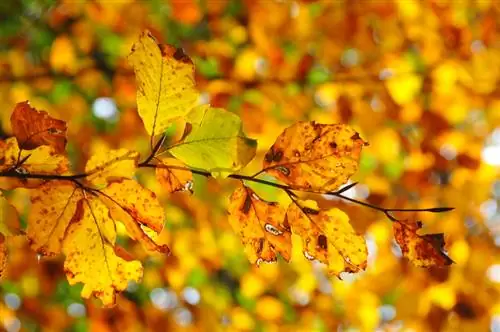- Author admin [email protected].
- Public 2023-12-16 16:46.
- Last modified 2025-01-23 11:20.
In addition to fungal diseases such as mildew, there are a number of pests that can occur on hornbeams. The younger the tree, the more damage they can cause. What you can do if you have a pest infestation.

What pests occur on hornbeams and how do you combat them?
Typical pests on hornbeams are gall midges, spider mites, scale insects, cockchafers, alder leaf beetles, frost moths, oak moths and mice. Small pests can be controlled by cutting back affected areas; larger pests should be collected. Mice in the garden must be kept away.
What pests occur on hornbeams?
- Gall midges
- Spider mites
- Scale insects
- Cockchafer
- Alder leaf beetle
- Frost Spinner
- Oak moth
- Mice
Identification features for various pests
If the leaf buds swell but do not sprout, gall midges are responsible. Spider mites and scale insects leave spots and small holes on the tops of leaves. You can discover the pests on the underside of the leaves.
The larvae and maggots of alder leaf beetles, frost moths, cockchafers and oak moths cause great damage to the leaves. You can often find the larvae and maggots or the beetles and moths themselves on the leaves.
If the hornbeam turns brown and dries out even though it has been watered frequently enough, mice may be responsible. They eat the roots. If there is severe damage, you can simply pull the hornbeam out of the ground.
Fighting pests
For small pests, generously cut off all affected parts of the plant. The hornbeam doesn't mind. It also recovers from a strong piece cut into the old wood.
Collect larger pests such as maggots and beetles. Stop ant trails leading to the hornbeam to combat lice.
If you have mice in your garden, you should definitely do something to keep them away from the roots of the hornbeam.
Prevent pest infestation
A he althy hornbeam is not affected by a slight pest infestation. Make sure that the hornbeam has ideal conditions.
Dryness or too much moisture promote pest infestation. Water younger hornbeams more often. This is no longer necessary for older trees.
Cut the hornbeam back several times a year, especially at the beginning. Cutting dramatically reduces the number of pests so the infestation doesn't become as severe.
Tip
If the spots on the tops of the leaves are multicolored, look under the leaves. If these are covered by a fungal lawn, the pest is a fungus that needs to be treated. The fungal disease mildew occurs even more frequently on hornbeams than animal pests.






